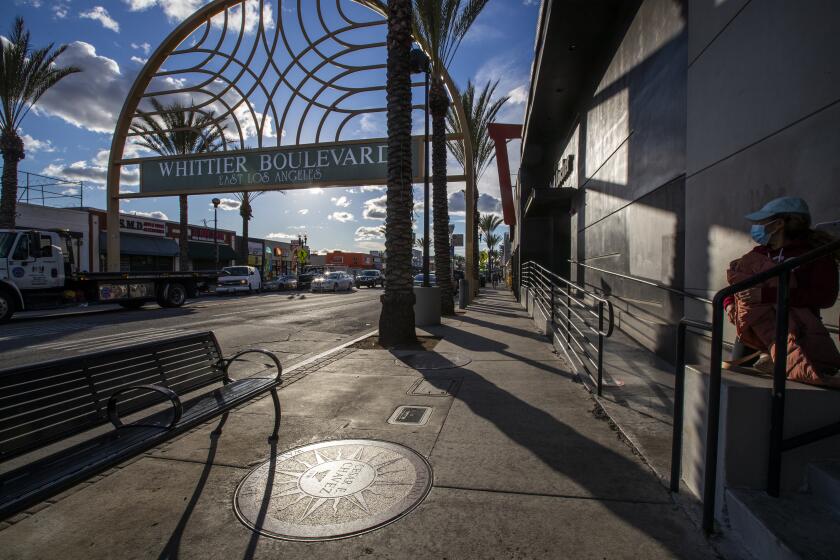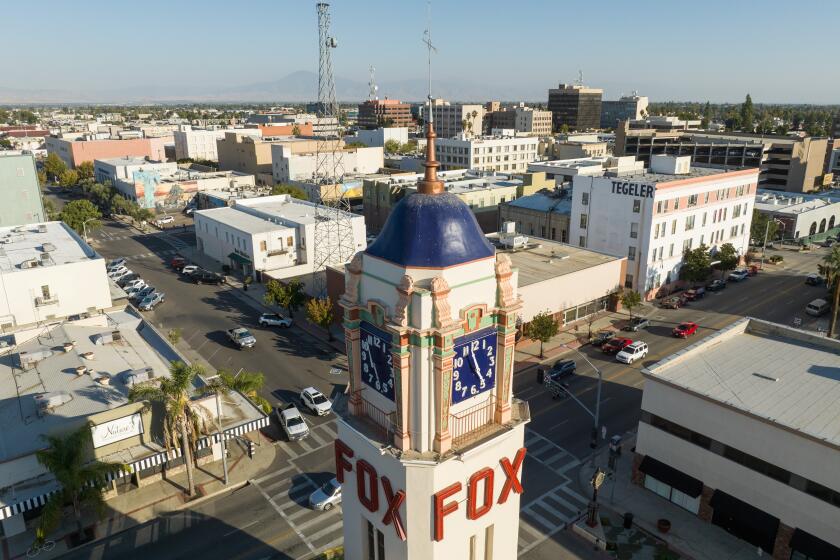Cerritos Thrives on Cash Cows From Old Pastures
The glass artwork at the Cerritos Library is top-drawer, of course. How could it be any other way?
The four stunning glass creations are the work of the internationally acclaimed Dale Chihuly, commissioned to do the pieces to the tune of $340,000. And on the second floor is an acrylic abstract by famed artist Al Held, who is $166,760 richer for it.
Still, these are drops in the bucket compared with the titanium skin that covers the $40-million library. The architects who built it say it is one of the few buildings in the world -- the Guggenheim Museum in Bilbao, Spain, being another -- that boasts such trappings. The Cerritos titanium shell cost a cool $2.7 million, but it never rusts and is guaranteed to last for 100 years.
Then there is the new sculpture garden, where a recently installed granite memorial commemorates a dark day in the city’s history: the 1986 air disaster in which two planes collided, killing 82 people and destroying 11 homes. Among the dead were 15 Cerritos residents.
Cerritos is the only city in Los Angeles County that financed the construction of its own sheriff’s station. And it provides deputies extra patrol cars, sophisticated fingerprinting equipment and other amenities.
All this for a city that only turned 50 this year. One that, until four decades ago, was a community of dairies where former First Lady Pat Nixon grew up.
But today’s lavish library and state-of-the-art Civic Center are the rewards of decisions made in the 1970s by visionary leaders who transformed cow pastures into sales tax-generating engines for decades to come.
While other cities were grappling with the crippling effects of Proposition 13, which capped property tax revenue, Cerritos was busy developing a regional shopping center and one of the first and largest auto malls in the nation. Today, 43% of the city’s sales tax revenue comes from Cerritos Auto Square.
“There’s a pretty simple answer to Cerritos’ success,” said Bill Fulton, an urban planning expert and author. “The answer is cars.”
Other Los Angeles County cities have tried to emulate Cerritos’ successful auto mall, but none comes close to rivaling it.
“There’s nothing magical about Cerritos,” Fulton said. “They just did it earlier and way better than anybody else.”
*
In the beginning, it was christened Dairy Valley, a fitting name for an area of Los Angeles County that at the time had more cows than people -- even if there was no valley.
“You’d see people stopped at the side of the road watching calves being birthed,” said Mayor Paul Bowlen, who spent much of his career as a civics teacher at Cerritos High School.
Longtime residents recall the constant swarm of flies and smell of manure that once filled the air.
“There was a cow field here that we used to play in. We loved the haystacks,” said Marcie Tracey, 44, who grew up in Cerritos and is now raising two sons in her childhood home.
Today, Cerritos, on the southern edge of Los Angeles County, is a prime example of the good life beyond Proposition 13, which brought on fiscal hardship for most cities.
This city of 8.9 square miles and 51,400 people, far from both the ocean and mountains, is a financial treasure trove. Its auto mall and two mega-shopping centers generate an estimated $18 million in annual sales tax revenue -- what its city manager calls its “lifeblood.”
The seeds of Cerritos’ success were planted only a generation ago, when neighboring Artesia was poised to annex the land and zone its dairies out of existence to make way for new homes. But disgruntled dairymen pushed for incorporation and Dairy Valley became a city in 1956.
Boasting a population of 3,500 and a $33,190 budget, Dairy Valley surrounded Artesia on three sides like a horseshoe. Today, as Mayor Bowlen is wont to point out, it’s easy to see where ritzy Cerritos ends and a somewhat more dog-eared Artesia begins.
In 1965, less than 10 years after the dairymen incorporated to keep subdivisions out, voters approved a measure that would allow them in. The farmers of Dairy Valley, renamed Cerritos in 1967, moved to more rural areas such as Chino, where suburban sprawl was not a threat.
And as their land came up for grabs, renowned developer Ernest W. Hahn snatched some of it up and proposed a regional shopping mall, now known as the Los Cerritos Shopping Center. As City Manager Art Gallucci said, “That was the goose that laid the golden egg.” The mall generates $4 million annually in sales tax revenue and was the city’s foundation for future projects.
Then in 1979, the Cerritos Redevelopment Agency spruced up Studebaker Road and lured a Chevrolet dealership, marking the beginnings of the Cerritos Auto Square. The auto mall was a radical concept at the time -- the bringing together of dozens of dealerships on a single piece of ground.
The square remains one of the world’s largest auto malls with 25 dealerships on 100 acres, generating $12 million in annual sales tax revenue.
*
Demographically, Cerritos isn’t very different from its neighbors. It is, in several aspects, a metaphor for the entire Southern California region.
It’s gone from rural to urban, Anglo to Asian, and been in on those home-bidding wars that are now part of the region’s lore. But it’s planned more wisely than many cities these last 50 years, taking its riches and investing them in the community. As a result, Cerritos thrives in a number of areas, from the arts to a posh senior center to first-rate schools that act as a magnet for the moneyed middle class.
Whitney High School in Cerritos, the highest-ranking public school in California, has attracted a drove of Asian American families hoping to qualify their children for enrollment. Asians make up 75% of its student population, while the city’s Asian population jumped from 45% in 1990 to 58% in 2000.
“We’re just here for the kids’ education, and then we’re out of here,” said Linda Ly, 40, a Vietnamese American pharmacist who moved with her husband and three sons to Cerritos five years ago. “Honestly, we can’t stay after they graduate. The costs are too high.”
Ly, watching her children play in the interactive water fountain at City Hall recently, said Asian families appreciate the money that the city spends on family- and education-oriented services.
“All of my sons are in summer school,” she said. “It’s not because they’re doing bad. It’s because the standards are so high that, if you don’t do that, you’re going to be behind.”
Joe Julien, a 64-year-old accountant who moved to Cerritos 33 years ago, said that he is surrounded by Asian neighbors, including a Korean family that lives across the street.
“I don’t talk to them a lot, but we wave at each other,” he said. “I feel like we’re at least communicating.”
Gloria Kappe, a Cerritos city councilwoman, said the social gap became so pronounced seven years ago that the city launched the annual Festival of Friendship to bring diverse neighbors together.
“The only problem is that all of the Chinese people would hang out at the Chinese booths, and the Indians would hang out at the Indian booths,” she said. “I think the kids are going to be the key that brings us all together.”
Things in Cerritos have unquestionably changed, but some of the past lingers. Streets still bear Portuguese names -- harking to a time when that was the dominant ethnicity -- and stables are still over by the auto mall.
Some residents yearn for those slower, quieter days. They complain that the auto center, shopping malls and top-notch schools have created parking and traffic issues. And with more traffic, they say, has come more crime.
Tracey’s mother was the victim of a car theft, and her father was eating at a local restaurant when an armed robbery occurred.
Tracey said a number of their neighbors’ cars have also been stolen in the last 15 years.
“We’ve been victimized,” she said. “The traffic’s brought a lot of bad people.”
But both city officials and residents agree that Cerritos has more to brag than complain about.
The city is still home to a multimillion-dollar library and performing arts center, an internationally recognized auto mall and some of the best schools in the nation.
Their pride in these landmarks has earned Cerritos a regional reputation as “arrogant and snooty.” But residents don’t mind the label.
“It’s probably true, but what’s the problem?” Julien asked. “When you’ve got it, you’ve got to flaunt it.”
*
*
Cerritos at a glance
Population: 51,488
Predominant race: Asian, 58.4%
Location: At convergence of the Santa Ana (5), San Gabriel River (605) and Artesia (91) freeways
Percentage of population with a bachelor’s degree or higher: 37%
Median household income: $73,030
Sales tax base: Cerritos Auto Square, Los Cerritos Center, Cerritos Towne Center
Total land area: 8.9 square miles
*
Source: U.S. Census Bureau and city of Cerritos
Los Angeles Times
More to Read
Start your day right
Sign up for Essential California for news, features and recommendations from the L.A. Times and beyond in your inbox six days a week.
You may occasionally receive promotional content from the Los Angeles Times.






